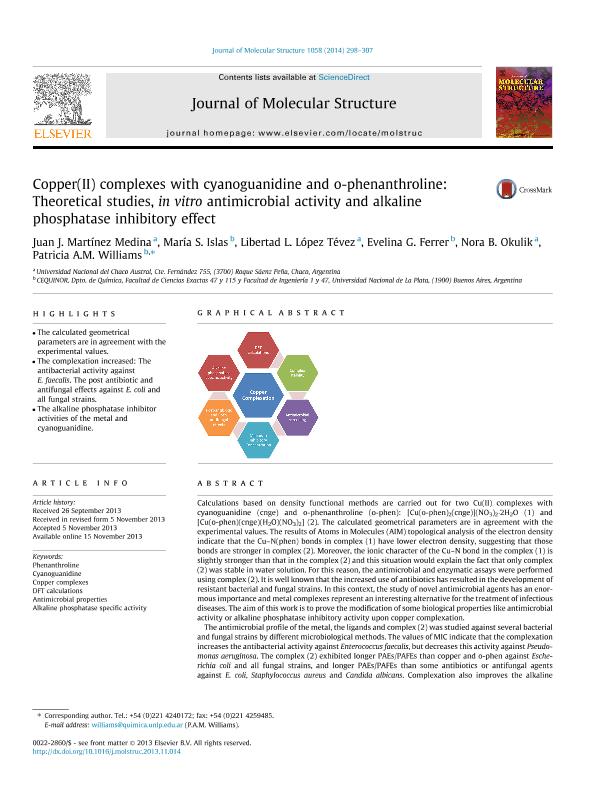Mostrar el registro sencillo del ítem
dc.contributor.author
Martínez Medina, Juan José

dc.contributor.author
Islas, María Soledad

dc.contributor.author
López Tévez, Libertad Leonor

dc.contributor.author
Ferrer, Evelina Gloria

dc.contributor.author
Okulik, Nora Beatriz

dc.contributor.author
Williams, Patricia Ana María

dc.date.available
2017-09-22T18:54:55Z
dc.date.issued
2014-01
dc.identifier.citation
Martínez Medina, Juan José; Islas, María Soledad; López Tévez, Libertad Leonor; Ferrer, Evelina Gloria; Okulik, Nora Beatriz; et al.; Copper(II) complexes with cyanoguanidine and o-phenanthroline: Theoretical studies, in vitro antimicrobial activity and alkaline phosphatase inhibitory effect; Elsevier Science; Journal of Molecular Structure; 1058; 1-2014; 298-307
dc.identifier.issn
0022-2860
dc.identifier.uri
http://hdl.handle.net/11336/24981
dc.description.abstract
Calculations based on density functional methods are carried out for two Cu(II) complexes with cyanoguanidine (cnge) and o-phenanthroline (o-phen): [Cu(o-phen)2(cnge)](NO3)22H2O (1) and [Cu(o-phen)(cnge)(H2O)(NO3)2] (2). The calculated geometrical parameters are in agreement with the experimental values. The results of Atoms in Molecules (AIM) topological analysis of the electron density indicate that the Cu–N(phen) bonds in complex (1) have lower electron density, suggesting that those bonds are stronger in complex (2). Moreover, the ionic character of the Cu–N bond in the complex (1) is slightly stronger than that in the complex (2) and this situation would explain the fact that only complex (2) was stable in water solution. For this reason, the antimicrobial and enzymatic assays were performed using complex (2). It is well known that the increased use of antibiotics has resulted in the development of resistant bacterial and fungal strains. In this context, the study of novel antimicrobial agents has an enormous importance and metal complexes represent an interesting alternative for the treatment of infectious diseases. The aim of this work is to prove the modification of some biological properties like antimicrobial activity or alkaline phosphatase inhibitory activity upon copper complexation. The antimicrobial profile of the metal, the ligands and complex (2) was studied against several bacterial and fungal strains by different microbiological methods. The values of MIC indicate that the complexation increases the antibacterial activity against Enterococcus faecalis, but decreases this activity against Pseudomonas aeruginosa. The complex (2) exhibited longer PAEs/PAFEs than copper and o-phen against Escherichia coli and all fungal strains, and longer PAEs/PAFEs than some antibiotics or antifungal agents against E. coli, Staphylococcus aureus and Candida albicans. Complexation also improves the alkaline phosphatase inhibitory effect of copper and cnge. Therefore, the interaction of copper(II) with N-containing ligands may provide a promising strategy for the development of novel drugs with enhanced antimicrobial activity or alkaline phosphatase inhibitory activity.
dc.format
application/pdf
dc.language.iso
eng
dc.publisher
Elsevier Science

dc.rights
info:eu-repo/semantics/openAccess
dc.rights.uri
https://creativecommons.org/licenses/by-nc-sa/2.5/ar/
dc.subject
Phenanthroline
dc.subject
Cyanoguanidine
dc.subject
Copper Complexes
dc.subject
Dft Calculations
dc.subject
Antimicrobial Properties
dc.subject
Alkaline Phosphatase Specific Activity
dc.subject.classification
Otras Ciencias Químicas

dc.subject.classification
Ciencias Químicas

dc.subject.classification
CIENCIAS NATURALES Y EXACTAS

dc.subject.classification
Bioquímica y Biología Molecular

dc.subject.classification
Ciencias Biológicas

dc.subject.classification
CIENCIAS NATURALES Y EXACTAS

dc.title
Copper(II) complexes with cyanoguanidine and o-phenanthroline: Theoretical studies, in vitro antimicrobial activity and alkaline phosphatase inhibitory effect
dc.type
info:eu-repo/semantics/article
dc.type
info:ar-repo/semantics/artículo
dc.type
info:eu-repo/semantics/publishedVersion
dc.date.updated
2017-09-18T14:31:40Z
dc.journal.volume
1058
dc.journal.pagination
298-307
dc.journal.pais
Países Bajos

dc.journal.ciudad
Amsterdam
dc.description.fil
Fil: Martínez Medina, Juan José. Universidad Nacional del Chaco Austral; Argentina. Consejo Nacional de Investigaciones Científicas y Técnicas; Argentina
dc.description.fil
Fil: Islas, María Soledad. Consejo Nacional de Investigaciones Científicas y Técnicas. Centro Científico Tecnológico Conicet - La Plata. Centro de Química Inorgánica "Dr. Pedro J. Aymonino". Universidad Nacional de La Plata. Facultad de Ciencias Exactas. Centro de Química Inorgánica "Dr. Pedro J. Aymonino"; Argentina
dc.description.fil
Fil: López Tévez, Libertad Leonor. Universidad Nacional del Chaco Austral; Argentina. Consejo Nacional de Investigaciones Científicas y Técnicas; Argentina
dc.description.fil
Fil: Ferrer, Evelina Gloria. Consejo Nacional de Investigaciones Científicas y Técnicas. Centro Científico Tecnológico Conicet - La Plata. Centro de Química Inorgánica "Dr. Pedro J. Aymonino". Universidad Nacional de La Plata. Facultad de Ciencias Exactas. Centro de Química Inorgánica "Dr. Pedro J. Aymonino"; Argentina
dc.description.fil
Fil: Okulik, Nora Beatriz. Universidad Nacional del Chaco Austral; Argentina. Consejo Nacional de Investigaciones Científicas y Técnicas; Argentina
dc.description.fil
Fil: Williams, Patricia Ana María. Consejo Nacional de Investigaciones Científicas y Técnicas. Centro Científico Tecnológico Conicet - La Plata. Centro de Química Inorgánica "Dr. Pedro J. Aymonino". Universidad Nacional de La Plata. Facultad de Ciencias Exactas. Centro de Química Inorgánica "Dr. Pedro J. Aymonino"; Argentina
dc.journal.title
Journal of Molecular Structure

dc.relation.alternativeid
info:eu-repo/semantics/altIdentifier/url/http://www.sciencedirect.com/science/article/pii/S0022286013009654
dc.relation.alternativeid
info:eu-repo/semantics/altIdentifier/doi/http://dx.doi.org/10.1016/j.molstruc.2013.11.014
Archivos asociados
